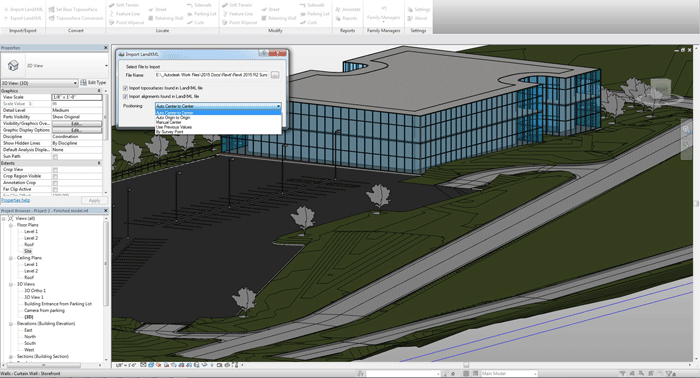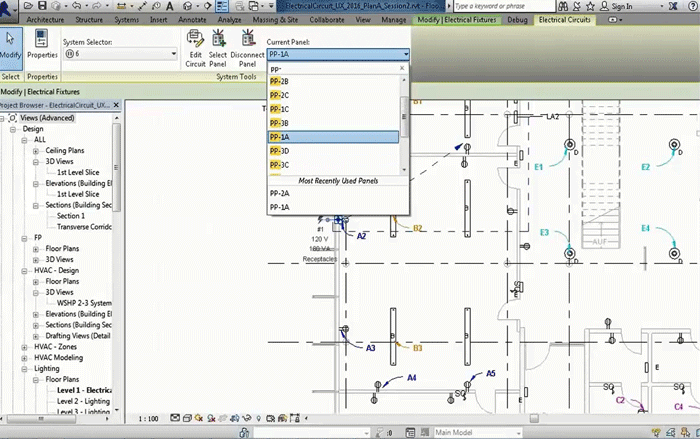We recently announced the beta version of Autodesk’s ‘Sundial’, its mid-life update to Revit. We are just in time to announce the launch of Revit 2015 R2
With Autodesk now striving for a pure Subscription-based customer base, the old days of the yearly upgrade clearly will not cut it anymore. When you pay a subscription fee you expect more than just the next release at the end of the subscription period. With adding value in mind, Autodesk’s AEC team had already planned a mid-life ‘beta’ refresh of Revit, with plenty of new and expanded features to please its installed base.
The preview of Sundial showed off some other technology that Autodesk has in development: namely the ability to run Revit as a hosted application. This means that Revit is not installed on a local hard drive, but hosted on Autodesk’s cloud servers. Revit has all the same functionality but is run remotely with the graphics appearing real time in a browser. The Sundial version of Revit can be run without any large downloads or installs and could even be used on a system with an existing Revit deployment.

This is a very clever move on Autodesk’s behalf, allowing users to experience running Revit on a hosted service. It does not mean that Autodesk is going to be removing the desktop version, but you can expect that running Revit over the web will be a valid option soon and, depending on your Internet connection, may prove to be one of the fastest ways to run the software, especially if your local machine currently struggles with large models.
Sundial R2 features
Autodesk Revit 2015 R2 includes over 30 user-requested features. Autodesk breaks down the R2 advantages into Power, Performance and Productivity.
In the power category, R2 has seen enhancements to Industry Foundation Classes (IFC) model referencing and can now link existing geometry in an IFC file as reference for dimension, alignment, snapping and hosting of some families in a Revit model.
There is a new ‘Reveal constraints mode’ to assist in the troubleshooting of ‘why did it do that?’ moments. In the new mode, Revit will make all dimension constraints and alignment constraints visible in the current view.
Autodesk’s open source computational design tool Dynamo is now automatically installed with Revit. Using visual programming and popular scripting, it is possible to drive Revit geometry by programmatic means, super charging the design process. If you have not tried Dynamo we highly recommend it, for all those designers into McNeel Grasshopper and Bentley Generative Components (GC).
Autodesk also announced Project Solon with R2, which provides web-calculated dashboards to give accurate energy analysis results from Green Building Studio, accessible through the Result and Compare dialog.

Performance is one of the all important updates for advanced Revit users. Autodesk says R2 is faster. Complex topology generation and building pads gets a boost. The energy analysis engine is faster and uses less memory on large models.
Rendering is faster and updates views with multiple instances of part families quicker. Links in views are also quicker.
In terms of productivity, R2 brings the capability to work in perspective views, which means you can make quick adjustments without having to change the style of view. There is a single click group option for quick editing of ‘wall join’ behaviour. The Type Selector gets search capabilities and PDFs can be navigated with hyperlinked views.
Site Designer
The biggest surprise in R2, which will get the warmest welcome, is that Autodesk is finally delivering a Revit extension that provides access to site planning tools. Called Site Designer Extension for Revit 2015, it is available for select Subscription customers and is based on an acquisition of site planning software formerly known as SiteWorks from Eagle Point Software Corporation.
Site Designer enables customers to shape the terrain for building sites. It runs natively within the Revit environment with the site design becoming part of the overall building model.
Users can model alternatives for mass grading, building pads, streets, pavements/sidewalks, parking spaces and retaining walls within the familiar Revit environment.
Site Designer automatically updates the underlying toposurface and can then be shared between Revit and Autodesk AutoCAD Civil 3D 2015 software through Land XML files, improving collaboration between architects and engineers.
Enhancements in Revit R2 specifically optimise the performance of Site Designer by speeding the edit and regeneration of complex site design elements.
Conclusion
Autodesk Revit R2 delivers a number of great new tools; and the site design element has been a long time in coming. IFC referencing improvements will be well received in the UK with the looming 2016 deadline for mandatory Building Information Modelling (BIM) usage on public sector projects and a corresponding increasing use of IFC files in federated projects.
There has been no mention with this release of Autodesk’s stated intent to try and retrospectively add some of these new features into previous releases of Revit, thus adding value to users stuck on old releases due to project constraints. Maybe there will be more on this later.
We are also waiting to hear on work to the Revit graphics pipeline that will enable it to get acceleration from GPU-enabled graphics cards.
If you enjoyed this article, subscribe to AEC Magazine for FREE






